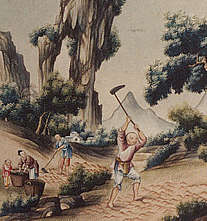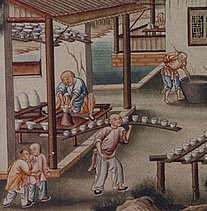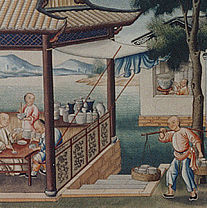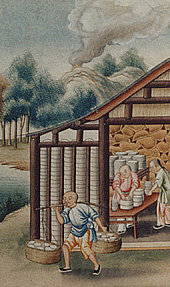
Section 2:
Reaching
Distant Lands
Mr. Yi: First
workmen dig the clay. Some of the very finest clay
comes from the Gaoling Mountains in the southeast,
a very scenic part of China. Everyone helps: A woman
and a child pack clay in barrels so it can be carried
to the ceramic works.
After the clay is specially treated with secret
ingredients....
Mr. Peters: What
secret ingredients?
Mr. Yi: You
know I can't tell you that, Mr. Peters. Now, as
I was saying, once the clay has been specially prepared,
the potter can begin his work. See the potter shaping
the bowl on the potter's wheel? He shapes the bowl
with his hands and turns the wheel with his foot.
Mr. Peters: Did
he make all of those bowls drying overhead and those
bowls that the workman is carrying away? Is that
all he does—shape the bowls?
Mr. Yi: Yes,
that is all he does. He studied for many years with
a master craftsman, and now he is a master himself.
Mr. Peters: Doesn't
he get bored? Our potters make most of a whole beer
mug or vase or bowl from start to finish—starting
with a lump of clay and working on each step until
it has been fired. But look how many pieces your
workman can make—and how fine the quality is.
We have much to learn from you.
Mr. Yi: Yes,
I am sure there is much we have to learn from you also.
Now here, in a peaceful pavilion by a mountain lake,
craftsmen paint patterns on porcelain as a workman
delivers more vessels for decoration. And finally,
after the porcelain has been painted, glazed, and
fired in the kilns, the finished pieces are packed
in barrels to be shipped to Canton, to Japan, even
to your home in England.
Now,
you can see how many pieces are made-see the stacks
and stacks of bowls? This is what they look like
after they come out of the kiln. When they are fired,
they are separated by clay dividers so they won't
stick together. As you know, the kiln fires heat
the clay so that it becomes very strong and hard.
And see the kilns' burning fires? When there is
a big order to be filled, the fires of the kilns
burn day and night.
|








